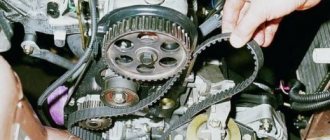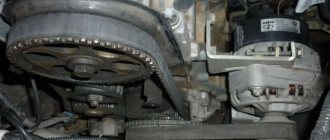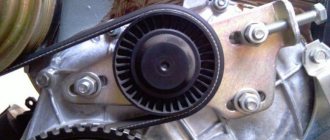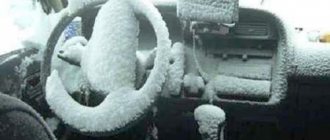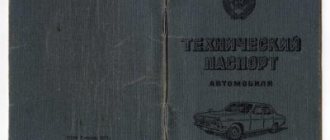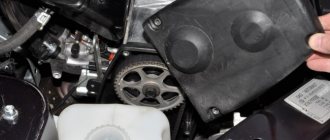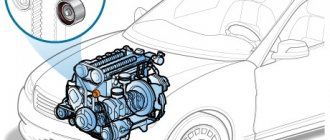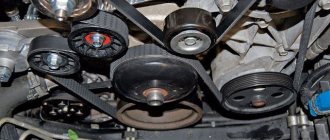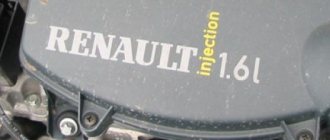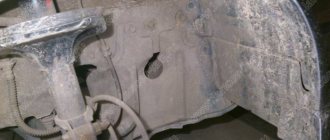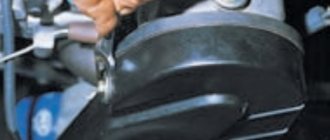The drive belt must have a certain traction capacity (the ability to transmit a given load without slipping) and sufficient durability. The traction capacity of the belt is ensured by its reliable adhesion to the pulleys, which is determined by the high coefficient of friction between them. The durability of a belt depends on the bending stresses that arise in it and the frequency of loading cycles—the number of belt runs per unit time. Using the recommendations below, you can ensure the required belt durability.
Flat belt.
There are several types of belts based on material and design. Standard flat belts include:
- rubber-fabric (GOST 23831 - 79),
- leather (GOST 18679-73),
- cotton all-fabric (GOST 6982-75)
- woolen (OSG/NKTM 3167).
Rubber-fabric belts.
Rubber-fabric belts are the most common. They come in two types: general purpose and frost-resistant. General purpose belts are designed to operate in the temperature range from -25 to +60°C, and frost-resistant belts - in the range from -45 to + 60°C. Rubber-fabric belts consist of a threaded fabric frame and rubber layers between the fabric pads. The frame of the belts is made from cotton fabrics or fabrics from combined threads (polyester and cotton fibers), or fabrics from synthetic threads. Some belts are made without rubber layers.
General-purpose and frost-resistant belts are manufactured both with external rubber pads (one or two) and without rubber pads. The fabric of the gaskets provides the belts with the required strength and durability, and the rubber serves as a binder for the belt, protects the fabric from damage, and increases the coefficient of friction between the belt and pulleys. Belts are made as final ones. Belt width 20... 1200 mm, number of gaskets 3...6, thickness 1.25-1.5 mm each. The end belts are connected by gluing, stitching or metal bonding.
Leather belts.
Leather belts are made from individual strips of leather by gluing them with special glue or stitching them together with rawhide straps (vein strings with a diameter of 1.5...3.5 mm). Standard leather belts are made with an end width of 20...300 mm and a thickness of 3...10 mm. Designed for transmission of small and medium powers.
They have good traction capacity, are durable and, from the point of view of reliability and durability, are preferable to others, especially when working under conditions of variable and shock loads. They have wear-resistant edges and can operate at speeds up to 45 m/s. However, due to their high cost, they are rarely used. Leather belts are completely unsuitable for working in damp rooms saturated with vapors of acids and alkalis, as they quickly deteriorate and fail.
Cotton seamless belts.
Cotton seamless belts are made (woven) from cotton yarn in several interlacing layers, usually with a final width of 30...250 mm, thickness 4.5...8.5 mm (corresponding to the number of layers 4...8). To protect against atmospheric influences, increase strength and durability, and also reduce shrinkage in the free state, they are impregnated with a special composition of ozokerite (mountain wax) and bitumen. Cotton belts are the cheapest, but in terms of load capacity and durability they are inferior to rubberized and leather belts, and therefore they are used primarily for transmitting low powers at speeds of up to 25 m/s. Cotton belts are not used for work in damp rooms or at temperatures above 50 °C, as well as when there is a risk of exposure to acid vapors.
Wool belts.
Woolen belts are made (woven) in several layers of wool and cotton threads, impregnated with a composition of drying oil, powdered chalk and red lead. They are less sensitive to the effects of elevated temperature, humidity, acid and alkali vapors, which determines the areas of application of these belts. Wool belts are made with end widths of 50...500 mm and thickness of 6...11 mm (corresponding to the number of layers 3...5). They have significant elasticity and therefore work well under uneven and shock loads. The maximum permissible speed is 30 m/s.
In addition to standard types of flat belts, in some special installations, stitched rubberized, woven semi-linen, silk, polyamide and other belts are used. At high speeds, endless woven half-linen belts are produced with a width of 15...25 mm, a thickness of 1.75 mm and a length of 1000... 1800 mm. Silk belts are used for high-speed transmissions. Polyamide belts have great prospects for use in domestic mechanical engineering. They are either woven from polyamide threads or obtained in the form of a film multilayer tape. Polyamide belts reinforced with thin metal cables are also used. Polyamide belts are several times stronger and more durable than ordinary ones. They are suitable for high-speed transmissions at belt speeds of up to 100 m/s and higher, transmissions with small center distances. They can transmit powers from very small to several thousand kilowatts. To increase the coefficient of friction between the belt and pulleys, polyamide belts are covered with synthetic rubber, polyvinyl chloride or friction linings made of chrome leather or cotton fabric.
Design advantage
The only difference from analogues is that this belt has truncated V-ribs. This design increases the flexibility of the product, improves resistance to crack propagation and reduces heat generation. Another additional advantage that these ribs provide is the ability to work at the highest speeds of rotation of pulleys with a small diameter. This also increases loading capacity. The poly V-belt gives good performance in tortuous drives and with considerable gear ratios. Also, in addition to all this, it is less demanding in terms of protection from the entry of various particles into the pulley grooves, and its special composition provides all products with excellent resistance to impact loads.
The specified drive belt can be of different types: with a cross-section PJ, PK, PL, PM and a length from 406 to 9931 millimeters.
Toothed belts.
Toothed belts (Fig. 1, a) combine the advantages of flat belts and toothed gears.
Protrusions (teeth) are made on the working surface of the belts, which engage with the protrusions (teeth) on the pulleys. Toothed belts are made from oil-resistant artificial materials, from rubber based on chloroprene rubbers, from vulcan, which are reinforced with steel wire ropes (Fig. 1, b), which absorb the load on the belt. For particularly light operating conditions (in control and measuring equipment), polyamide cord is used instead of steel cables. Such belts can operate in oil. To increase wear resistance, timing belts are sometimes covered with nylon fabric. Toothed belts are installed without pre-tensioning; they work without slipping and silently. Compared to a conventional belt drive, they are much more compact and have higher efficiency. Toothed belts are produced in widths of 5...380 mm, for transmitting power up to 200 kW and higher at speeds up to 80 m/s. Rice. 1
3.8. V-ribbed belt
The poly V-belt drives all important auxiliary units: the generator, the servo oil pump, the coolant pump and, in vehicles with air conditioning, also the air conditioning compressor. If the V-shaped belt with its many longitudinal ribs were to break, it would cause serious engine damage. Therefore, the poly V-belt is extremely reliable. It is not subject to verification. Of course, it doesn’t hurt to occasionally take a quick look at the serpentine belt, because... it is subjected to quite a lot of stress. The belts run on V-belt pulleys, these are deep groove pulleys. The edges of the groove are in contact with the edges of the belt. Thanks to this, the flow of force is transmitted, but for this the belt must be tensioned.
Over time, the edges of the serpentine belt wear off, it slides deeper into the groove, and its tension weakens slightly. This deviation is corrected by an automatic tension device. However, as already mentioned, verification is never unnecessary.
Checking the belt surface
|
Checking belt tension
|
Dismantling and installation of poly V-belt
Dismantling and installing a poly V-belt is labor-intensive. Before dismantling, you need to remove the engine splash guard or soundproofing bath and draw an arrow on the belt in the direction of travel with chalk, a felt-tip pen or a wax pencil. When viewed from the belt side, the engine rotates to the right, i.e. clockwise. Marking the direction of movement is important for the possible installation of the same ribbed belt. Installation against the previous direction of movement increases wear and may lead to belt failure.
The tools needed to carry out this work, depending on the engine, are: SW 15 or 16 key, hex key 3449 (for three-cylinder petrol engines) and locking pin T10060 (for all diesel engines).
Engines ACV, AJT, AUF, AYC
|
A typical serpentine belt arrangement is shown in the pictures below:
| Position of the poly V-belt for a three-cylinder petrol engine AWY/AZQ: The illustration shows a belt drive without an air conditioning compressor. |
| The illustration shows a belt drive with an air conditioning compressor. |
| Position of the poly V-belt on a three-cylinder TDI AMF/BAY diesel engine: The illustration shows the belt drive without the air conditioning compressor. |
| The picture shows a belt drive with an air conditioning compressor. |
| Position of the poly V-belt for four-cylinder petrol engines AUA/BBY, AUB/BBZ: The figure shows a belt drive with an air conditioning compressor. |
| Position of the poly V-belt on four-cylinder TDI ATD/AXR diesel engines: The illustration shows the position of the belt on vehicles with an air conditioning compressor. The arrow shows the direction of rotation to loosen the tension element. |
carmanz.com
V-belts.
V-belts for general purpose drives are made in two designs: cord fabric and cord cord.
Cord fabric V-belts (Fig. 2, a) consist of several layers of rubberized textile cord fabric 2, which transmits the main load and is located approximately symmetrically relative to the neutral layer of the belt; rubber or rubber-fabric tensile layer 1 located above the cord; rubber or, less commonly, rubber-fabric compression layer 3 located under the cord; several layers of wrapping rubberized fabric 4. In cord cord V-belts (Fig. 2, b), instead of layers of cord fabric, there is one layer of cord 2 with a thickness of 1.6 ... 1.7 mm, a tensile layer 1 of medium-hard rubber and a compression layer 3 of harder rubber rubber. These belts, being more flexible and durable, are used under difficult working conditions. Rice.
2 V-belts are made of three types: normal section, narrow and wide (variable). Belts of normal section (GOST 1284.1 - 80; 2-80; 3-80) are the main ones in general mechanical engineering. In accordance with GOST, these belts are manufactured in seven different sized sections: O, A, B, C, D, D and E. These belts are made in an infinite number of different standard lengths. Profile angle φ0=40° . The permissible maximum speed for profiles O, A9 B and C is up to 25 m/s, for profiles G, D and E up to 30 m/s.
V-belts for driving agricultural machines are standardized by GOST 10286 - 75. For automotive engines, special cord fan belts with increased flexibility are manufactured (GOST 5813 - 76). For V-belt drives with pulleys of small diameters, belts with corrugations are used (Fig. 2, c). They produce V-belts with a cord made of polyamide fibers, which are used under difficult operating conditions (high speeds and vibrations, small pulley diameters, etc.). To ensure greater load-bearing capacity and durability, V-belts with a cord of steel cables are used. These belts can operate at speeds up to 60 m/s.
V-belt: device and application
A V-belt is the main connecting device that is used in the manufacture of various types of machines, mechanisms and machines with moving components. This tool transmits the inertial rotational movements of the engine (or any other mechanism) and brings them into final contact. In this case, the V-belts bypass the corresponding pulleys during operation and transfer of forces from one mechanism to another.
It is worth noting that the cross-section of this instrument forms a kind of isosceles trapezoid. Moreover, its shape may differ significantly from the specific standard by which a given belt model is produced.
Peculiarities
Each V-belt model is manufactured using a special technology, taking into account the addition of several layers of rubber, bonded together using high-quality adhesive. The main layers of this tool are:
- Wrap covering.
- Compression and tension layer.
- Traction layer.
Each of the above layers allows the product not to lose its elasticity properties under the enormous loads that act on it during engine rotation and transmission of traction. Thus, the presence of several layers and coatings in this device provides a guarantee for the longest possible service life. V-belts can withstand enormous loads for a very long time and not break to the point of wear. However, if at least one tear has formed on its surface, this means that such a tool is no longer suitable for further use. It is simply impossible to repair or restore the properties of such a belt, and the presence of cracks and other deformations will certainly lead to a breakdown of the mechanism. It is only a matter of time before this happens, but the fact that the damaged layer of the device will constantly worsen the characteristics of the entire mechanism remains unchanged.
Rubber quality
A part such as a V-belt can only contain the most heat-resistant and oil-resistant types of rubber. These requirements are determined by the operating conditions of this mechanism, since its operation is always accompanied by constant heating and friction. In addition, the V-belt must have high wear resistance qualities. In some cases, the temperature of this device during constant operation can reach more than 100 degrees Celsius. Taking into account the fact that such a V-belt is in a constant state of suspension and transmits forces from one mechanism to another, low-quality parts will fail immediately after the first hours of operation. Real belts (for example, those used for timing belts of cars) can operate up to 80-90 thousand kilometers without a single tear or deformation.
Textile fiber
To achieve maximum strength and wear resistance, these tools include special textile fiber. On broken belts it can be seen in the very first layers - these are thin intertwined threads that are very difficult to break even with a knife.
fb.ru
How it works?
The air conditioner and alternator attachment belt transfers the driving energy from the crankshaft pulley to the pulleys of the connected devices. For ease of installation and tension regulation, it is carried out using hydraulic or mechanical tension systems. The drive system also uses guide rollers to establish the optimal route for the belt, as well as eliminate its operating vibrations. The poly V-belt is specially designed for heavy duty transmission of high-quality torque of more than 350 Nm.
Operation of the accessory drive belt
What belts are currently used?
The most in demand at the moment for implementing this function is the V- belt of attachments.
, which is capable of creating a non-rigid transmission of torque from the crankshaft to the water pump, generator and other equipment. Nowadays, in order to increase productivity, poly V-belts are increasingly being used, with the help of which it is possible to reduce the bending radius and increase the gear ratio. Due to the often limited installation space, auxiliary equipment in some car models is driven by both sides of the belt.
This modern hanging belt ensures the operation of a powerful generator that powers the vehicle's on-board electronics, as well as all the auxiliary devices installed in it.
Characteristic
Dozens of modern manufacturers of spare parts and components and assemblies have now launched the production of poly-V-belts (PR). Alternator belts for a car can be found in any relevant store, and such a huge selection of manufacturers can confuse buyers. Therefore, we will understand the characteristics of poly-V straps, their areas of application and other issues.
It will be useful: How to decipher an error on an opel zafira car: instructions and photos
As for the main characteristics:
- fairly high efficiency, which averages about 98%;
- can be used in various components and installations at extremely high speeds;
- high-quality PRs create a minimal noise level;
- depending on the dimensions, they may well be used on shafts even with a minimum diameter, which is less than
Poly V-belts today represent one of the most modern means for transmitting energy from the drive to the driven shaft. Energy transfer occurs as a result of frictional contact of the working surface of the drive belt with wedge-shaped teeth.
Grooved belts are the result of long and consistent work on the development of drive components. The straps combine the characteristics of strong elasticity and optimal power transfer between nodes. PR is a drive element between several drive shafts. In the chain of elements in which PRs operate, a drive tension component is necessarily used.
As a rule, PR consists of the following components:
- Bearing layer. Manufacturers make this layer from durable composite threads that are distributed around the perimeter of the belt. These threads have a slight linear elongation and are quite firmly connected to the main layer. The result is maximum stability over the entire length of the strap, even under high tensile forces. This achieves the function of optimal transfer of large loads.
- Coatings. If the coating is flexible and has a long service life, this allows for high protection of the load-bearing layer. In addition, a high-quality coating can work even longer on poly-V-ribbed tension roller gears.
- Just the basics. The base is a series of parallel teeth with a V-shaped cross-section. With the help of these teeth, reliable adhesion to the shaft is ensured, as well as uniform distribution of the load along the entire perimeter of the PR. Typically the base layer is made of a durable material, such as a polychloroprene elastomer base, coated with cross-fiber reinforcement.
Application
Such products find their application in:
- difficult operating conditions;
- in units with high gear ratios;
- at high speed nodes;
- in units with small diameter belt shafts.
There are many areas of application of PR. Poly-V-ribbed products are used not only in generators in automobile or tractor production. Many manufacturers involved in the production of machine tools use PR in their technologies. In this case, manufacturers have the opportunity to increase the accuracy of the elements that undergo processing. Manufacturers have learned to reduce noise levels, as well as the time spent on preparatory activities for diagnosing and servicing machines. It should be noted that with the use of PR in the industry, a number of parameters for the formation of transmission ratios in nodes have been revised.
In what areas are PRs used?
- in automotive production for gas distribution mechanisms, generators, air conditioners, pumps;
- in the automotive and tractor industry (in manufacturing in particular);
- in the machine tool industry;
- in household appliances;
- in metallurgy;
- in chemical production;
- in the production of agricultural machinery;
- at nodes in the military industrial sector;
- and even in the field of nuclear energy.
Dimensions
As for the sizes, we'll talk about this later. Poly V-belts for a car generator can be of different sizes. It all depends on the manufacturer, as well as the specifics of the unit. After all, poly V-belts can be used not only in generators, but also in air conditioners, gas distribution mechanisms, and so on. Below are the sizes according to GOSTs, as well as sizes from some manufacturers.
GOST standards for PR sizes
Symptoms of a problem
Even the highest quality products are subject to mechanical wear over time. And this, in particular in the case of generators, can affect traffic safety and the operation of the engine as a whole. Therefore, it is necessary to pay attention to diagnosing the condition of the PR in order, if necessary, to replace it as quickly as possible. Any damage is unacceptable.
So what you need to pay attention to when diagnosing PR:
- First of all, on its external condition. By the appearance of a PR you can quickly determine its quality. If the strap shows damage or signs of mechanical wear or delamination, this indicates an immediate need to replace the PR.
- It is necessary to pay attention to the presence of traces of contamination and the appearance of fuel and lubricants not only on the PR, but also on the pulleys. Ingress of engine fluid may adversely affect the operation of the belt.
- In general, on the tension of the drive belt. If the belt is hanging down, it needs to be tightened. If the PR hangs down, then a characteristic whistle will appear when the generator is operating.
- In addition to everything, you regularly need to inspect the condition of not only the PR itself, but also the tension rollers. It must be borne in mind that they become unusable as a result of constant loads, and this can affect not only the tension coefficient, but also the quality of operation of the PR.
When replacing a belt, we recommend that you immediately change the rollers, and the condition of both the belt and the rollers should be checked every 15 thousand kilometers.
If the date for replacing the Pr is just around the corner, you will be able to hear third-party sounds, as mentioned above. According to professionals in the automotive industry, the PR generator in a car should be replaced at least every 50 thousand km. It is worth considering that the belt deflection coefficient should not exceed 0.5 cm. If this is the case, then the belt must be tightened. If this does not help, then you need to check the functionality of the tension rollers; they may need to be replaced or adjusted.
All the basic information has been reviewed by us, and the choice of a specific manufacturer is a matter for consumers. When purchasing, you need to pay attention to the quality of the purchased products, because the reliability of all components of the vehicle depends on this. Remember, expensive belts are not always of high quality, and not all cheap products are always made “anyhow”. Today you can find both cheap and high-quality belts.
